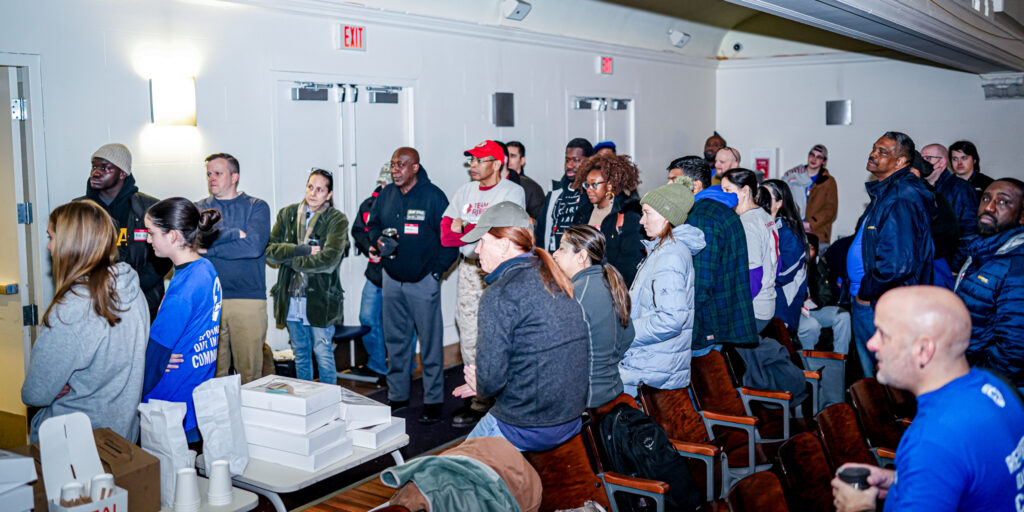“Education means emancipation,” said Frederick Douglass in an 1894 speech, “It means light and liberty.” He was speaking at the dedication of Virginia’s Manassas Industrial School for Colored Youth, which was founded in 1893 by a formerly enslaved woman to provide African Americans with a technical education. “To deny education to any people,” Douglass said, “is one of the greatest crimes against human nature.”
Douglass knew of what he spoke. Born into slavery in Maryland, he was forbidden an education and illegally learned to read from an old Webster’s spelling book. He escaped from the cruelty of American slavery and, once the abysmal institution was fully abolished nationwide, put great effort into promoting education for his community—a legacy that continues to this day and in which Team Rubicon was proud to recently participate at a school in the Washington D.C. neighborhood of Anacostia, where Douglass lived for nearly 20 years.
This year, Team Rubicon’s Go Day, an annual service day celebrating the veteran-led organization’s inaugural event, coincided with Martin Luther King Jr. Day. In Washington, D.C., a group of Team Rubicon volunteers, or Greyshirts, marked Go Day and MLK Day in service by joining community volunteers—including the U.S. Secretaries of Commerce and Veterans Affairs, the retired 16th Sergeant Major of the Marine Corps and his wife, the veteran-led nonprofit The Mission Continues, and students from Howard University and other Historically Black Colleges and Universities—to help refurbish a high school just half a mile from Douglass’s home.

Sitting in D.C.’s 8th Ward, the city’s southernmost district, Anacostia has deep ties to Black history. At the outset of the Civil War, as the federal government fortified the Ward to protect the nation’s capital from Confederate attack, thousands of African Americans fled to Anacostia for refuge from their now-besieged former masters. Still more came once the District permanently ended slavery within the city in 1862. After the war, the Freedmen’s Bureau established America’s first planned community for African Americans in Anacostia.
Anacostia today, however, bears the weight of more than a century of impoverishing policies that followed and generations of neglect to infrastructure. The neighborhood Douglass once inhabited is now known as a low-income community—with all the related problems.
“This neighborhood is tough and not a very accessible part of town,” said Greyshirt and D.C. native Advaith Thampi. “The school has seen better days, and there was a lot that had to be done.”
As the only public high school in a neighborhood facing a 30% poverty rate, Anacostia High has faced its share of challenges. “It’s a very large high school with a very small student population in a very underserved area,” explained Clyde Darren Thompson, D.C.-area Platoon Leader for The Mission Continues, which had organized the event. “The school had needs: programs they wanted to expand but didn’t have capacity for, projects they wanted to pursue but couldn’t; they needed help clearing clutter and opening space.”
An urban gardening and farming project being run in conjunction with the University of the District of Columbia required more room to grow; a dance studio had yet to be assembled; a new computer lab demanded clear areas for donated computers and devices, and peeling paint and missing tiles in areas throughout the school begged for attention.
“It was an important event,” said Thampi, a U.S. Marine veteran who has volunteered in disaster zones with Team Rubicon for years, “you could see that in who showed up to help.”
To conduct the Go Day and MLK Day service project, roughly 100 volunteers braved the traffic and closed roads of a public holiday with parades and worked in the cold and snow to help one of America’s oldest African American communities freshen up its neighborhood public high school. They showed up on their day off to add some fresh paint, to empty classrooms of years of accumulated random objects that were preventing the school from initiating important educational programs, and to help the community create a better educational experience for their children.
“We all came together,” said Greyshirt Anthony Graves. “The students wearing their Howard University sweaters, the Greyshirts working hard, the staff being so appreciative, and the Martin Luther King Jr. Day parade going on at the same time just a few blocks away; this is the idea of service. It was beautiful.”
Now that the MLK Day service project is over and so many classrooms have been decluttered, that college-level urban gardening curriculum truly has space to grow. The dance studio has been thoroughly cleaned and is ready for use. The donated enhancements to their computer labs and library spaces can be installed. Education, to echo Douglass, will not be denied.
“They no longer have to worry about setting up,” said Thompson, “they can store their materials for the computer labs, offer dance classes, and build up the gardening program. They’re ready and able to do more to pursue their mission.”
Relieving school administrators, teachers, and parents of the burden of cleaning hallways, clearing classrooms, and painting walls empowers the school to think of the future and make plans.
“This relationship with Team Rubicon is such a beautiful collaboration,” said Thompson. “The way love works is when you show up with good intentions; it allows people to show who they are in the best light, to do their best work. The sky’s the limit.”



